Part 3
UNION OF LUBLIN, CREATION OF POLISH-LITHUANIAN
COMMONWEALTH – 1569
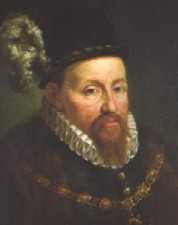
Just about the time when in most European countries the kings were strengthening their rule, the power of the Polish kings waned. Even the successful lineage of the Jagiellonians did not revert all the evil caused by the earlier confusion. Once endowed with special privileges in 1385, the nobles never gave them up. In fact even during the rule of the Jagiellonian dynasty, they were able to use occasional weaknesses to get more power. Before his death, king Sigismund Augustus, the last of the Jagiellonian Dynasty, attempted to establish a set of structures that would unite the Kingdom of Poland and the Grand Duchy of Lithuania into a single workable unit. Although he enjoyed popular consent, he still had to deal with the power of nobility, which had grown significantly in the years since the Piast era. Nothing could be done without the consent of the powerful great nobles or magnates, who were driven by self-interest. Weak monarchy and state structure were to their benefit because they helped them increase their own power, whereas a powerful state might limit their freedom.
It was against this fractious background that Sigismund carried out the Union of Lublin. When he brought the south-eastern areas of greater Lithuania into the kingdom of Poland, the Lithuanian magnates finally consented to the union. Theoretically, every member of the noble estate (the szlachta) in Poland-Lithuania had the same political rights. This sector accounted for 10% of the population, a far larger class than in other European countries. In the context of the times, this arrangement appeared to constitute a democratic regime because a far larger proportion of the population enjoyed full political rights than those in the Western European countries.
The death of Sigismund Augustus in 1572 marked the start of the Royal Nobility Republic (Rzeczpospolita Szlachecka) of the Polish-Lithuanian Commonwealth.
ELECTING THE KING – 1573
With the death of Sigismund Augustus in 1572, the Royal Republic faced the prospect of electing a king from outside a reigning native dynasty. On the outskirts of Warsaw, in the vast field of Wola, 40,000 nobles, all representatives of their entire estates, gathered to vote. The meeting of the Sejm began peacefully with approval of the Maintenance of Freedom of Conscience and Religious Tolerance in the Confederation of Warsaw. Once these tenets were recognized as principles of public life, Poland stood out as a bastion of liberty guaranteeing freedom and religious tolerance in the darkest hour of European religious wars, and producing spectacular culture in which money was of less value than honor.
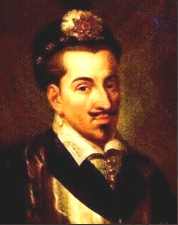 Subsequently, the nobility elected the new king of Poland; it was to be French prince Henri de Valois. But in 1574, barely several months after ascending the throne, faced with the opposition of Polish gentry, Henri secretly returned to France to wear the French crown after his brother’s sudden death. Chaos followed in the wake of Henri’s departure. An incredible array of candidates vied for the Polish crown and it was only through the influence of a patriotic faction that the great warrior-king Stefan Batory was elected.
Subsequently, the nobility elected the new king of Poland; it was to be French prince Henri de Valois. But in 1574, barely several months after ascending the throne, faced with the opposition of Polish gentry, Henri secretly returned to France to wear the French crown after his brother’s sudden death. Chaos followed in the wake of Henri’s departure. An incredible array of candidates vied for the Polish crown and it was only through the influence of a patriotic faction that the great warrior-king Stefan Batory was elected.
There were a number of elements in the Polish constitution that contributed to the country’s instability. Interregna often led to periods of weakness, when various foreign factions pursued their own interests, outbidding each other for the right to name the king. The liberum veto, originally conceived as a safeguard against tyranny, stipulated that a single deputy in the Sejm or the Diet (deputies were elected at Sejmiki or Dietines around the country), by his use of the veto if he strenuously objected to a piece of legislation, could cause the dissolution of a sitting of the Sejm. Matters got even worse when the veto law was amended to require that all legislation in a particular sitting of the Sejm be annulled. A democracy that required complete unanimity often resulted in gridlock.
In 1596, king Sigismund Vasa moved his residence from Krakow to Warsaw because Warsaw’s strategic and more centralized location made it a more convenient site for meetings of the Sejm and the Royal Court.
WARS WITH RUSSIA, SWEDEN, THE OTTOMAN EMPIRE AND THE DNIEPER COSSACKS
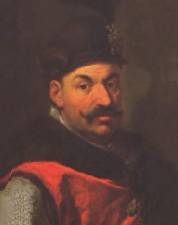
From the time of Stefan Batory’s reign (1576-1585), Poland was involved in constant warfare with Muscovy (Russia). The early part of the 17th century saw a brief turn in the tide when Poland gained the upper hand by intervening in the civil war that engulfed Russia upon the death of Ivan the Terrible. For a time, it even seemed likely that the throne of the Tsars would go to a Polish prince. But the moment passed and Poland, once again, was threatened with Russian imperialism.
Russia’s counter-attack after its „Time of Troubles,” was ferocious. Even worse was the Commonwealth’s inability to integrate the Dnieper Cossacks. They could have been formed into a cohesive military force but the state’s lack of funds made it impossible. Besides, the gentry’s plan was to keep the Cossacks as serfs. The situation was complicated by religious differences that flared between the Roman Catholic and Orthodox churches. To add to the trouble, discontent with serfdom was reaching a boiling point. For years, the nobility had been enriching itself at the expense of the common people. As economic conditions deteriorated, dissatisfaction with feudal serfdom intensified. The self-interest and in-fighting of the nobility poisoned the atmosphere, preventing a peaceful solution to the problem. The result was a fierce rebellion led by Bohdan Khmelnitsky. The Dnieper Cossacks began a revolt that quickly spread throughout the Ukraine. To help in their struggle they sought association with the Muscovian rulers. By the time they realized they were falling into the hands of a vicious regime, it was too late to return to the more lenient Polish rule.
To make matters worse, Sweden, a leading military power of the day, hoped to win an easy battle over the weakened Commonwealth. With fresh memories of an earlier defeat in the war for what now are the Baltic Republics of Latvia and Estonia, the Swedes moved in force into the Polish territory. At the same time, the ruler of East Prussia became independent of Poland, while much of the Polish Protestant nobility went over to the side of the Swedes. The only resistance came from the peasantry and burghers who were outraged by the rapacity of the Swedes. The turning point in the war occurred during the defense of the Monastery of Jasna Gora at Czestochowa. Under the leadership of Stefan Czarniecki, the spirited defense became a symbol of national resistance, stirring the nobility to launch guerrilla actions against the occupying Swedes. By stretching its resources to the limit, the Commonwealth managed to field an army of over 100,000 men and were finally able to drive the enemy out. Poland’s troubles, however, were not over. The Ottoman Turkish Empire threatened the country’s southern borders and, as the price of peace, Poland was forced to pay an infamous tribute to the Sultan.
SOBIESKI’S RELIEF OF VIENNA – 1683
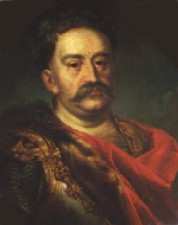
Jan III Sobieski was a tough martial ruler with extraordinary military talents. His first great victory over the Turks at Chocim in 1673 propelled him to the throne. In 1683, he led the Polish army of 30,000 men to relieve Vienna besieged by the Turks. The charge of the huzaria, Polish heavy cavalry, smashed the Turkish lines and ended once and for all the centuries old Turkish threat to Central Europe.
Sobieski’s relief of the Hapsburg capital catapulted him to fame, but he soon became embroiled in seventeen years of fruitless warfare against the Ottoman Empire, which he continued to fight under the banner of the Holy League. With his attention fixed on the Turks, Sobieski failed to deal with the far more pressing menace of Prussia, which was quickly becoming a powerful state. Prussia’s territories now extended from Berlin through Western Pomerania to East Prussia, threatening the Polish lands that lay in between. Sobieski failed also in other ways. He underestimated the threat of Russia which had recently incorporated most of Ukraine into its realm and he neglected badly needed internal political reforms. When he died in 1696 the Commonwealth, balancing on the edge of bankruptcy as a result of the costly wars, once again faced the chaos of electing a successor who was championed by the self-serving nobility.
In the period that followed Sobieski’s death, the country virtually disintegrated. This era, known as the Saxon Period, occurred under the rule of Saxon dukes Augustus II and Augustus III. A number of despotic neighboring rulers (Peter the Great and Catherine the Great of Russia as well as Frederick the Great of Prussia) menaced Poland’s borders, sending rampaging armies crisscrossing through a virtually defenseless land. The only bright spot during this desperate period was the brief rule of Stanislaw Leszczynski, a benevolent leader who tried to initiate reforms. With the defeat of his champion, Charles XII of Sweden, Leszczynski was exiled to Lorraine and Poland plunged back into darkness.
THE FIRST PARTITION – 1772
At the beginning of the 1700s, the Commonwealth fell under the influence of Tsarist Russia, although no direct annexations were made at this time. The country was surrounded by three new powerful states, each ruled by strong, capable monarchs: Peter the Great in Tsarist Russia, Frederick the Great in the Kingdom of Prussia, and Maria Theresa in the Austrian Empire. It was inevitable that these monarchs, faced with a weak state in their midst, would turn to partitions at Poland’s expense.
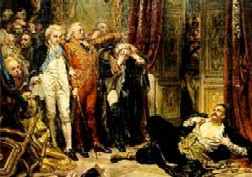
The First Partition took place in 1772 when Frederick the Great consolidated Prussia by seizing the Polish territories laying between East Prussia and Western Pomerania, with the sole exception of Gdansk, which remained associated with Poland. Maria Theresa captured the then south-western slice of Poland, including Krakow and Lwow, later to become known as „Galicia”. Catherine the Great, heir to Russia’s Peter the Great, took a slice of the northeast. Faced with this triple blow, despite heroic attempts on the part of patriotic delegates, the Polish Sejm was forced to accede to the partition.
One positive result of the First Partition was to awaken the Commonwealth from its state of lethargy. Polish cultural and political Enlightenment resulted in period of reforms, which culminated with the adoption of the new Constitution on May 3, 1791.
Które bonusy w legalnych kasynach internetowych są najlepsze? Cóż, wszystko zależy od osobistych preferencji gracza i sytuacji, w jakiej się znajduje. W najlepszej pozycji są gracze, którzy sprawdzili topowe darmowe sloty i dopiero zakładają konto w kasynie. Na nich czeka bowiem bonus powitalny. Bonus Ice Casino czy free spiny w Lemon Casino pozwalają zacząć grę na plusie. Tego typu bonusy w kasynach zwykle mają najwyższą wartość i mogą wynieść w przypadku niektórych kasyn ponad 10 000 złotych za kilka pierwszych wpłat. Istnieją bonusy, na przykład bonus bez depozytu, które nie wymagają od gracza żadnej wpłaty. Po prostu możemy dostać od operatora pieniądze za zarejestrowanie konta, weryfikację naszych danych osobowych w systemie, z okazji urodzin czy po osiągnięciu jakiegoś statusu VIP. Darmowe obroty z premii i gotówkę gracz ma prawo wykorzystać na grach udostępnianych przez dane kasyno, w tym najlepsze gry Always Hot Deluxe – oczywiście w tym wypadku wszystko zależy od polityki danego operatora.